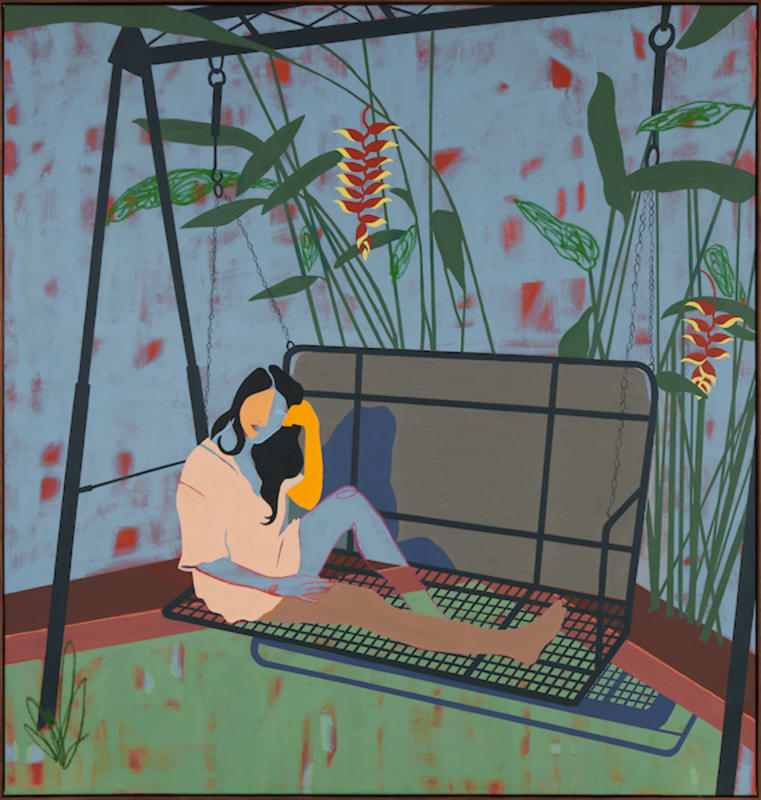For I Resemble Everyone But Myself, how did you approach the canvas?
I would say it’s really my most intimate show yet, because it delves not into just my journey as an immigrant woman, as an Indian woman living in the States—which has in general been a lot about what my practice has been about—but I think, with this show, it takes it a step further, because I really dive back into my ancestry, and the women that came before me for this exhibition.
How has learning about your grandmothers made you reflect upon your own experience?
[I spent] over a month in India last year conducting a pretty in-depth research project, which allowed me to dive into sort of these untold stories of my grandmothers, who are both still with us, to really serve as the inspiration for this show. Lately, I’ve been thinking a lot about this notion of cultural assimilation—how when I first moved to the states, it was seen as such a green check mark for me to fit into the environment. So I got comments like, ‘I can’t believe your English is so good. I can’t believe you grew up in India because you fit so well into this society.’ It felt in a way like I was receiving a trophy for having to actually shapeshift myself. But at what cost? What are the personal, intimate, and cultural costs of having to fit into society? What do you leave behind? What parts of yourself do you feel like you have to conceal? My grandmothers grew up in Pakistan, and then, during the Partition of India in 1947 under British rule, they were, I guess, forcibly displaced and had to move to India. So for them having to move to India and assimilate into a foreign context was by force. Whereas for me, moving to America and living here has been by choice. But regardless of if it was by force or choice, the three of us—both my grandmothers and myself—have had to sort of fit into a foreign context and change our lives, change our identities, camouflage ourselves in many ways in order to fit into these new worlds.I think as an immigrant you do it so much more because you are usually moving between vast polarities of culture. That’s kind of what the work is about: how we’re simultaneously visible and invisible at the same time. And how we have to reveal different parts of ourselves and hide different parts of ourselves in different contexts, or how much we choose to put into the foreground versus how much we choose to fall into the background.
What do you hope viewers will take home with them?
While I was uncovering these stories with my grandmothers in India, it was reinforced that so many stories are really promoted through the male perspective, or highlighted through the male perspective. I knew my grandfather’s story like the back of my hand, but I had no idea about the stories of my grandmothers and their journeys. And I was only learning them in my mid-thirties, which was kind of heartbreaking to some extent, and also really intensely emotional, beautiful, and healing. Something I’m hoping people take away, too, is that it’s the importance of the female perspective, the importance of sharing female stories, and putting them to the forefront.
That makes me want to speak with my grandmother. It feels radical to think of her as a young woman, to know who she was before she met my grandfather.
That’s exactly where I was. It took me having to actively ask those questions because they’re not used to sharing [their story]. It’s all sort of swept under the rug, and somehow it’s innately believed that our stories aren’t that important. For us to start having those conversations, I think there was so much healing in the telling of the story, but also in the receiving of the story. And what I realized, actually: these women are so powerful. They broke every single pattern that they could in order for me to be able to break patterns. It is like you said: this transfer of not only generational trauma, but also generational power.
How do you keep your heart open and yet remain soft?
It was really through my art practice that I had a real rediscovery of my identity, and my Indianness, and my womanhood. And so I think now it’s so clear to me that this is my path, because I’ve lived the other path, and I know that it wasn’t right. When you’re on the right path, it feels so honest and real and raw that I think there’s no choice but to be vulnerable.

